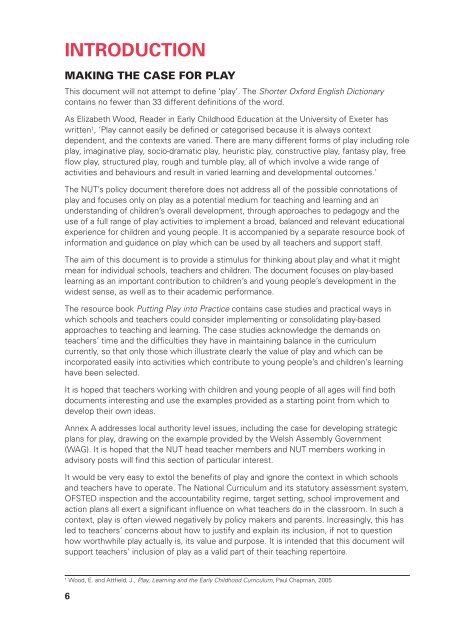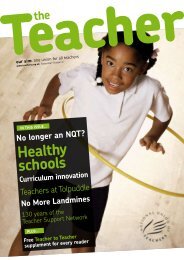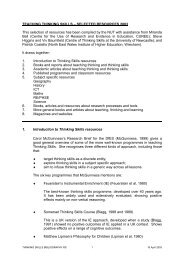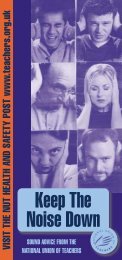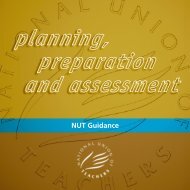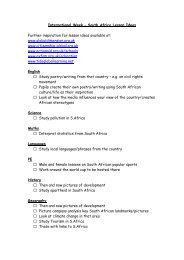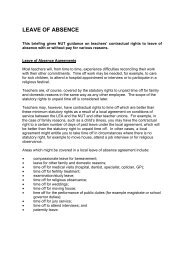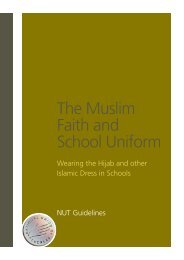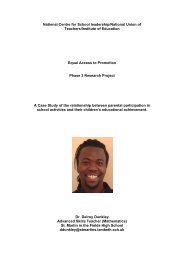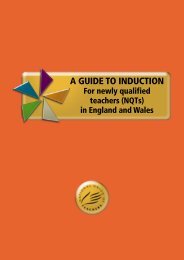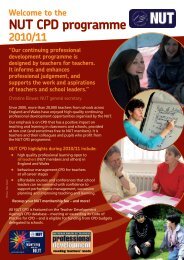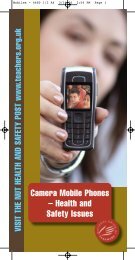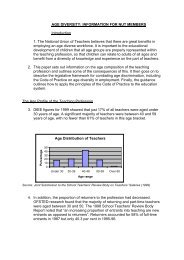NUT play policy - National Union of Teachers
NUT play policy - National Union of Teachers
NUT play policy - National Union of Teachers
You also want an ePaper? Increase the reach of your titles
YUMPU automatically turns print PDFs into web optimized ePapers that Google loves.
INTRODUCTION<br />
MAKING THE CASE FOR PLAY<br />
This document will not attempt to define ‘<strong>play</strong>’. The Shorter Oxford English Dictionary<br />
contains no fewer than 33 different definitions <strong>of</strong> the word.<br />
As Elizabeth Wood, Reader in Early Childhood Education at the University <strong>of</strong> Exeter has<br />
written 1 , ‘Play cannot easily be defined or categorised because it is always context<br />
dependent, and the contexts are varied. There are many different forms <strong>of</strong> <strong>play</strong> including role<br />
<strong>play</strong>, imaginative <strong>play</strong>, socio-dramatic <strong>play</strong>, heuristic <strong>play</strong>, constructive <strong>play</strong>, fantasy <strong>play</strong>, free<br />
flow <strong>play</strong>, structured <strong>play</strong>, rough and tumble <strong>play</strong>, all <strong>of</strong> which involve a wide range <strong>of</strong><br />
activities and behaviours and result in varied learning and developmental outcomes.’<br />
The <strong>NUT</strong>’s <strong>policy</strong> document therefore does not address all <strong>of</strong> the possible connotations <strong>of</strong><br />
<strong>play</strong> and focuses only on <strong>play</strong> as a potential medium for teaching and learning and an<br />
understanding <strong>of</strong> children’s overall development, through approaches to pedagogy and the<br />
use <strong>of</strong> a full range <strong>of</strong> <strong>play</strong> activities to implement a broad, balanced and relevant educational<br />
experience for children and young people. It is accompanied by a separate resource book <strong>of</strong><br />
information and guidance on <strong>play</strong> which can be used by all teachers and support staff.<br />
The aim <strong>of</strong> this document is to provide a stimulus for thinking about <strong>play</strong> and what it might<br />
mean for individual schools, teachers and children. The document focuses on <strong>play</strong>-based<br />
learning as an important contribution to children’s and young people’s development in the<br />
widest sense, as well as to their academic performance.<br />
The resource book Putting Play into Practice contains case studies and practical ways in<br />
which schools and teachers could consider implementing or consolidating <strong>play</strong>-based<br />
approaches to teaching and learning. The case studies acknowledge the demands on<br />
teachers’ time and the difficulties they have in maintaining balance in the curriculum<br />
currently, so that only those which illustrate clearly the value <strong>of</strong> <strong>play</strong> and which can be<br />
incorporated easily into activities which contribute to young people’s and children’s learning<br />
have been selected.<br />
It is hoped that teachers working with children and young people <strong>of</strong> all ages will find both<br />
documents interesting and use the examples provided as a starting point from which to<br />
develop their own ideas.<br />
Annex A addresses local authority level issues, including the case for developing strategic<br />
plans for <strong>play</strong>, drawing on the example provided by the Welsh Assembly Government<br />
(WAG). It is hoped that the <strong>NUT</strong> head teacher members and <strong>NUT</strong> members working in<br />
advisory posts will find this section <strong>of</strong> particular interest.<br />
It would be very easy to extol the benefits <strong>of</strong> <strong>play</strong> and ignore the context in which schools<br />
and teachers have to operate. The <strong>National</strong> Curriculum and its statutory assessment system,<br />
OFSTED inspection and the accountability regime, target setting, school improvement and<br />
action plans all exert a significant influence on what teachers do in the classroom. In such a<br />
context, <strong>play</strong> is <strong>of</strong>ten viewed negatively by <strong>policy</strong> makers and parents. Increasingly, this has<br />
led to teachers’ concerns about how to justify and explain its inclusion, if not to question<br />
how worthwhile <strong>play</strong> actually is, its value and purpose. It is intended that this document will<br />
support teachers’ inclusion <strong>of</strong> <strong>play</strong> as a valid part <strong>of</strong> their teaching repertoire.<br />
1<br />
Wood, E. and Attfield, J., Play, Learning and the Early Childhood Curriculum, Paul Chapman, 2005<br />
6


